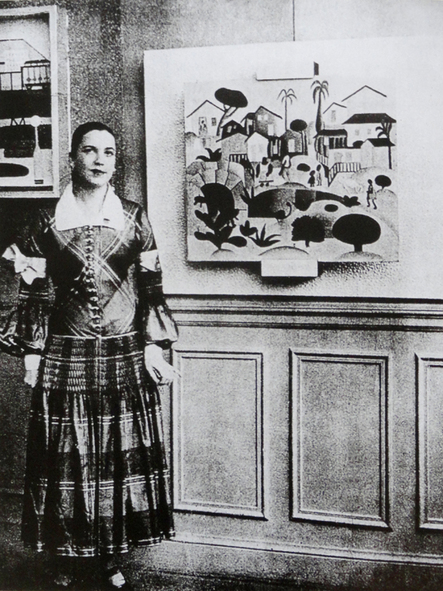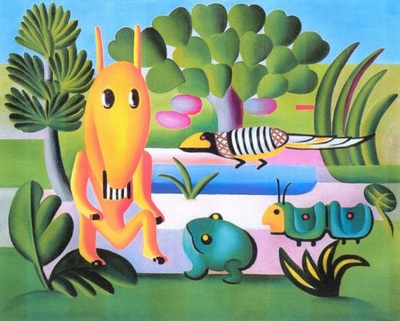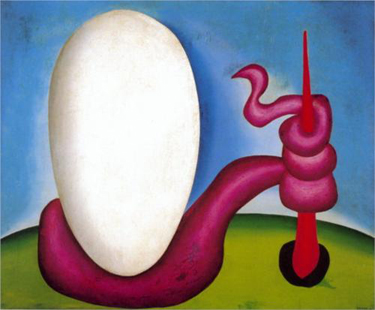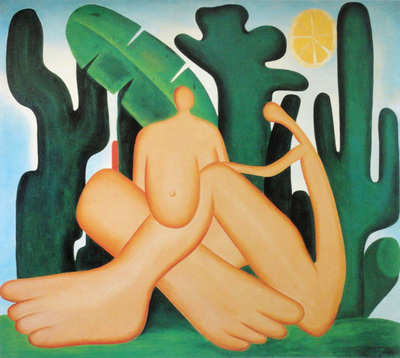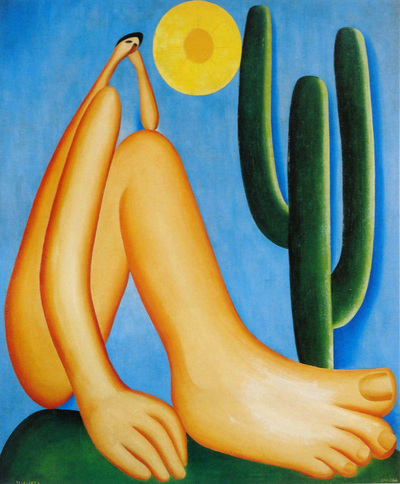TARSILA DO AMARAL 1886 -1973
Tarsila do Amaral was a painter and a pioneer of modernism (Modernismo) in Brazil. She grew up on her parent’s coffee plantations in the province São Paulo. In 1916 she began studying art in São Paulo. In 1920 she went to Paris for the first time, in order to study at the Académie Julian. In 1922 she returned to São Paulo and founded the “group of five” (Grupo dos Cinco) together with Anita Malfatti, Oswald de Andrade, Mário de Andrade and Menotti De Picchia, which aimed to find a unique, Brazilian variant of modernism. The same year, she traveled to Paris again, and was introduced to avant-garde artists such as Fernand Léger, Constantin Brancusi, Jean Cocteau and Eric Satie by the writer Blaise Cendrars. Subsequently Tarsila (her artist name) develops her own visual language, inspired by Cubism and Surrealism, which is also increasingly shaped by Brazilian influences (carnival, colonial baroque, art of the indigenous Brazilian peoples). In 1928 her most famous painting is created, Abaporu, (anthropophagus: maneater or cannibal in the language of the Tupi Indians). Her partner, author Oswald de Andrade, is inspired to write his influential Manifesto Antropóphago after seeing this painting. He counters the cleanliness, scientificity and “European desire for difference” with “the tropical rampancy, appropriation, naïveté, wildness and poetry.” We must “[...] incorporate the cultures of Europe, re-appropriate them, and regurgitate them as an entirely new and unique creation. We must stop imitating them and instead do something transform them into something new.” The Tropicalismo movement that developed in Brazil in the 60s with artists such as Helio Oiticica and Lygia Clark drew on the ideas of the Anthropagy movement. In the 30s, Tarsila’s style changed again, shifting towards the Mexican muralists and early Socialist Realism. In 1938 she returned to São Paulo permanently, and played a leading role in the expansion of modern art in Brazil. Marcus Weber Quellen: Exhibition Catalogue, „Tarsila - viajante,Viajera“, Pinacoteca do Estado de São Paulo, Malba-Fundación Constantini, Buenos Aires, 2008 http://en.wikipedia.org/wiki/Tarsila_do_amaral http://tarsiladoamaral.com.br Scroll down for German version |
TARSILA DO AMARAL 1886 -1973
Tarsila do Amaral war eine Malerin und Wegbereiterin der Moderne (Modernismo) in Brasilien. Sie wächst auf den elterlichen Kaffeeplantagen in der Provinz São Paulo auf. 1916 beginnt sie mit einem Kunststudium in São Paulo. 1920 fährt sie erstmals nach Paris, um an der Académie Julian zu studieren. 1922 kehrt sie nach São Paulo zurück und gründet zusammen mit Anita Malfatti, Oswald de Andrade, Mário de Andrade und Menotti De Picchia die „Gruppe der Fünf“ („Grupo dos Cinco“), deren Anliegen es ist, einen eigenen brasilianischen Weg innerhalb der Moderne zu finden. Im gleichen Jahr reist sie wieder nach Paris und lernt dort über den Schriftsteller Blaise Cendrars Künstler der Avantgarde wie Fernand Léger, Constantin Brancusi, Jean Cocteau und Eric Satie kennen. In der Folge wird Tarsila (ihr Künstlername) eine eigene, von Kubismus und Surrealismus inspirierte Bildsprache entwickeln, die zunehmend von brasilianischen Einflüssen (Karneval, Kolonialbarock, Kunst der indigenen brasilianischen Völker) geprägt wird. 1928 entsteht ihr bekanntestes Bild „Abaporu“, dessen Titel in der Sprache der Tupi –Indianer Anthropophage, also Menschenfresser bzw Kannibale bedeutet. Ihr Lebensgefährte, der Schriftsteller Oswald de Andrade, schreibt, nachdem er ihr Bild gesehen hat, sein einflussreiches „Manifesto Antropóphago“. Der Reinlichkeit, Wissenschaftlichkeit und dem "europäischen Verlangen nach Differenz" setzt er "das tropische Wuchern, Aneignung, Naivität, Wildheit und Poesie" entgegen: "... Wir müssen uns die Kultur Europas aneignen, sie aufessen, um sie dann wieder als etwas Eigenes auszuspucken. Wir müssen aufhören, sie zu imitieren und stattdessen zu etwas Neuem verarbeiten …". Die in Brasilien in den 60er Jahren entstehende Bewegung des „Tropicalismo“, der KünstlerInnen wie Helio Oiticica und Lygia Clark angehören, knüpft an die Ideen der „Antropophagie- Bewegung“ an. In den 30er Jahren ändert sich Tarsilas Bildsprache erneut und nähert sich den mexikanischen Muralisten und den Anfängen des sozialistischen Realismus an. 1938 kehrt sie endgültig nach São Paulo zurück und engagiert sich maßgeblich für die Verbreitung der modernen Kunst in Brasilien. Marcus Weber Quellen: Exhibition Catalogue, „Tarsila - viajante,Viajera“, Pinacoteca do Estado de São Paulo, Malba-Fundación Constantini, Buenos Aires, 2008 http://en.wikipedia.org/wiki/Tarsila_do_amaral http://tarsiladoamaral.com.br Hochscrollen zur englischen Version |
